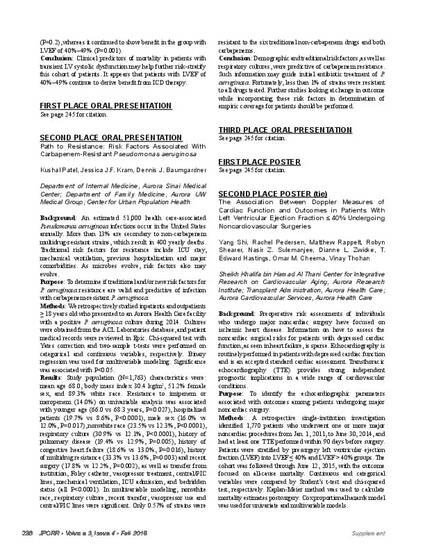
- ejection fraction,
- heart failure,
- echocardiography
Background: Preoperative risk assessments of individuals who undergo major noncardiac surgery have focused on ischemic heart disease. Information on how to assess the noncardiac surgical risks for patients with depressed cardiac function, as seen in heart failure, is sparse. Echocardiography is routinely performed in patients with depressed cardiac function and is an accepted standard cardiac assessment. Transthoracic echocardiography (TTE) provides strong independent prognostic implications in a wide range of cardiovascular conditions.
Purpose: To identify the echocardiographic parameters associated with outcomes among patients undergoing major noncardiac surgery.
Methods: A retrospective single-institution investigation identified 1,770 patients who underwent one or more major noncardiac procedures from Jan. 1, 2011, to June 30, 2014, and had at least one TTE performed within 90 days before surgery. Patients were stratified by presurgery left ventricular ejection fraction (LVEF) into LVEF ≤ 40% and LVEF > 40% groups. The cohort was followed through June 12, 2015, with the outcome focused on all-cause mortality. Continuous and categorical variables were compared by Student’s t-test and chi-squared test, respectively. Kaplan-Meier method was used to calculate mortality estimates postsurgery. Cox proportional hazards model was used for univariate and multivariable models.
Results: In patients with LVEF > 40%, the 1-, 6- and 12-month mortality rates were 3.8%, 9.0% and 12.1%, respectively. In patients with LVEF ≤ 40%, 1-, 6- and 12-month mortality was 9.5%, 18.4% and 25.2%, significantly greater than patients with LVEF > 40% at all time points (P < 0.01). Univariate analysis of patients with LVEF ≤ 40% found the following echocardiographic parameters to be significant predictors of 6-month mortality: right atrial pressure, pulmonary artery systolic pressure, LVEF < 25%, mitral A-wave velocity, mitral E-wave deceleration time, and left ventricular posterior wall diastolic thickness. Multivariate analysis identified mitral A-point velocity (hazard ratio [HR]: 0.98, P = 0.02), LVEF < 25% (HR: 3.48, P < 0.01), glomerular filtration rate (HR: 0.71 at 10-unit increments, P < 0.01) and colectomy (HR: 5.47, P < 0.01) as significant predictors of 6-month mortality.
Conclusion: Preoperative LVEF < 25%, lower mitral A velocity, colectomy, and lower glomerular filtration rate are associated with 6-month mortality postsurgery. Close preoperative cardiac assessment of patients with decreased LVEF prior to noncardiac surgery may prove beneficial in improving long-term outcomes.
Shi Y, Pedersen R, Rappelt M, Shearer R, Sulemanjee NZ, Zwicke DL, Hastings TE, Cheema OM, Thohan V. The association between Doppler measures of cardiac function and outcomes in patients with left ventricular ejection fraction ≤ 40% undergoing noncardiovascular surgeries. J Patient Cent Res Rev. 2016;3:236-7.
